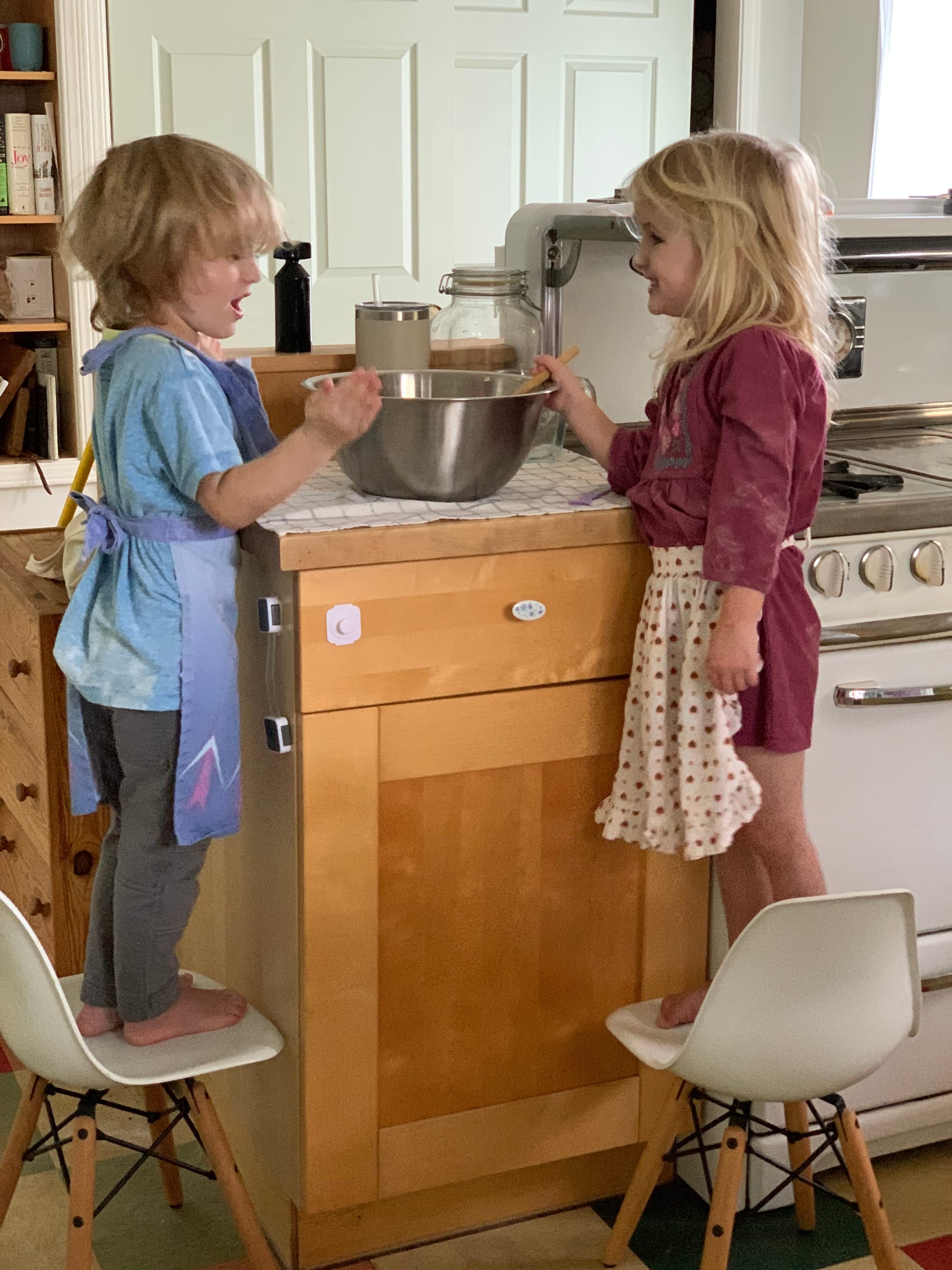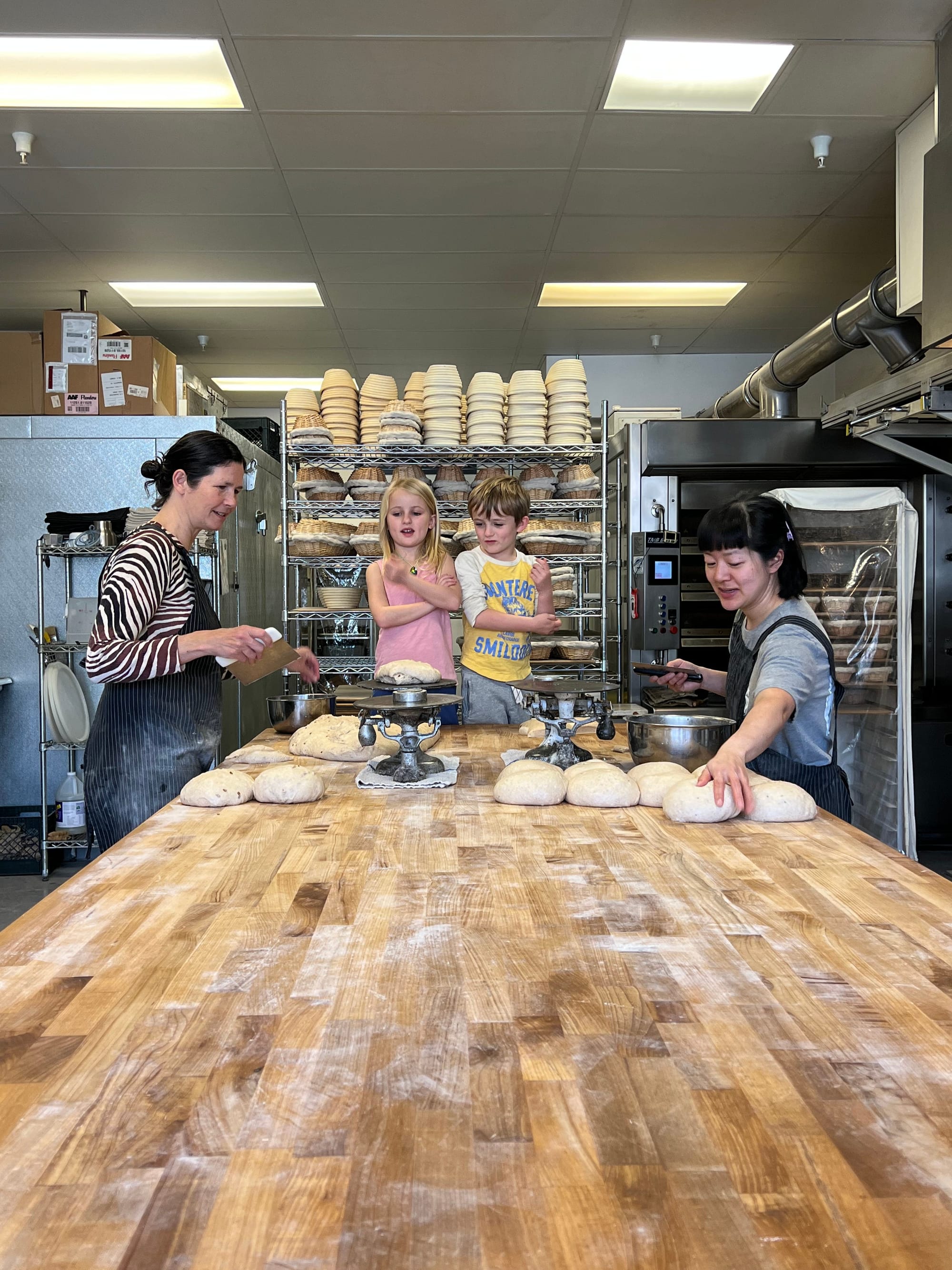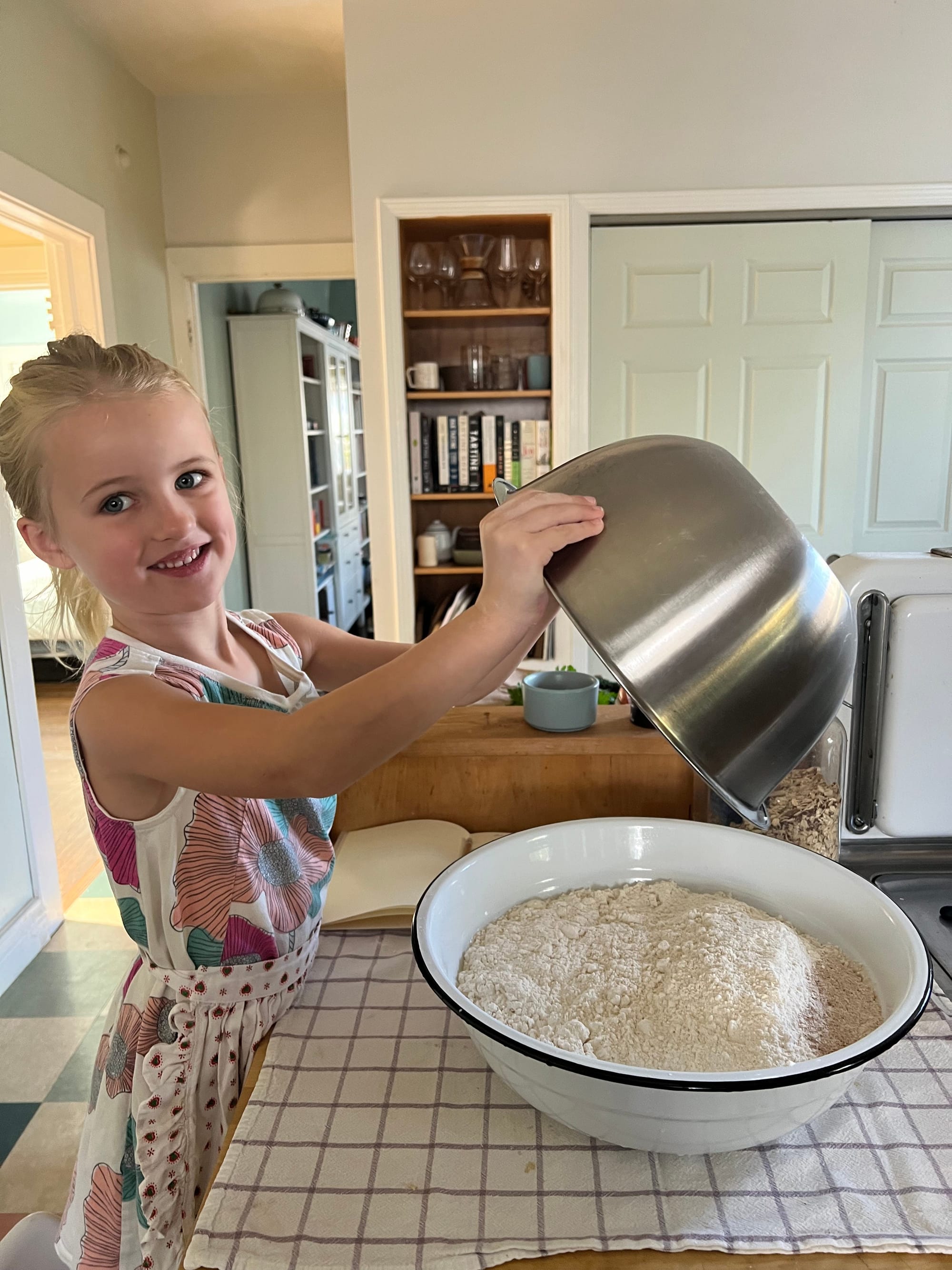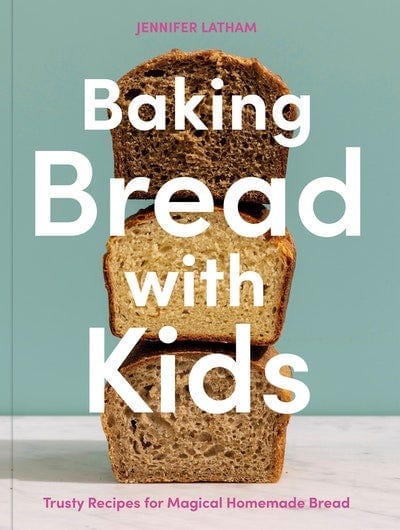'Baking Bread with Kids,' by Jennifer Latham
Excerpts and a giveaway!

Table of Contents
Below are the two “fundamentals” sections from Jen Latham’s Baking Bread with Kids, one for kids, and one for adults. (The photos are from Jen’s personal collection, not the book.) Ten Speed Press sent me a copy of BBWK to give away to one lucky Wordloaf subscriber. Just comment below with your favorite bread baking project to do with little ones (or one you’d like to do someday). I’ll select one winner at random on Wednesday, March 29. If you’re not a subscriber yet, you know what to do:
—Andrew

Fundamentals for Kids
There are a few things to keep in mind as you bake that will help you be a more successful and happier baker. Take a few minutes to read through some principles of baking before starting; it will save you time and frustration during the baking process.
Plan lots of time
All of these recipes have a guideline for how much time to expect to work on them. I estimated a little more time than you might need, since everyone makes recipes at different speeds. The more you bake, the more you’ll get to understand your own process and how long it will take you to do things.
There is quite a bit of down time in bread making while you wait for doughs to ferment or proof (rise). Usually when I plan to make bread, I also plan to do other things around the house for the day—whether it’s gardening or reading a good book—and I go back and forth between the two. Sometimes I’ll do yoga or go for a run while I’m waiting for something to bulk-ferment. Whatever it is, it’s a good idea to keep yourself busy. If you don’t keep busy, you’ll end up staring at your dough, which seems to resist rising the more you stare at it.
How to choose what to make
If you’ve never baked bread before, it’s a good idea to start with the simpler recipes like honey whole wheat or focaccia. Keep the breads with the complicated shaping or long list of ingredients (like pretzels or baguettes) for later, after you’ve gotten comfortable with some of the easier breads. (Look for the skill level at the top of each recipe.) That being said, make whatever inspires you. The whole experience will be the most rewarding if you are making something that delights you.
Read all the way through the recipe a few times
It is very easy to miss a step or instruction the first time you read through a recipe. There is a lot of information in each one. One of the more common mistakes that even master bakers make is that they assume they know what a recipe is going to tell them to do. Then they do what they assume instead of what is instructed. Before getting any ingredients ready, read the recipe once to get a general idea, then go back and read it slowly one or two more times to make sure you’re not missing anything.
Imagine yourself performing the steps of the recipe
Read each step of the recipe and picture yourself doing what the instructions indicate, such as gathering the ingredients. Do you have everything you need or do you need to go shopping? Is there anything you need to warm up or bring to room temperature (like butter or eggs) before you start?
Picture yourself mixing the ingredients. Think about what size bowls and how many of them you might need. Will you need a spoon, a spatula, or a mixer? Read each step carefully and think about what it will look like when you’re doing it.
Think of questions that might come up and try to answer them before you get started
As you’re imagining these steps, think through any questions or curiosities. Maybe you’re not sure if you need a baking stone or steel for this project. Maybe you’re
not familiar with what is meant by some of the terms, like development or proofing. If there’s anything you’re unsure about, there are a few things you can do. You can look the terms up in the index of this book. (See Terms on page 000; see Troubleshooting on page 000.) You might be able to find your answers listed in the key terms or the recommended equipment. If you can’t find answers to your questions in this book, you can try another baking book or you can do research online. You can also enlist the help of a friend or an adult assistant. It’s a lot easier to get things cleared up before you start baking, rather than trying to search the internet with dough on your fingers.

Set up your workspace
Once you’ve chosen your recipe and read it a few times, it’s time to start gathering the things you’ll need. In professional kitchens this is often called mise en place (pronounced meez-ahn-plahss), a French term meaning “everything in its place.” Make sure you have an open, tidy space to work in. Gather all the ingredients you’ll need. Gather your equipment, including clean linens or dishtowels and a hand towel.
Try to keep everything clean and tidy as you go—messes are a slippery slope and tend to just get bigger, which can lead to confusion and missteps. Take your time, move deliberately and with intention, and tidy up your last step before moving onto the next. Washing dishes and putting ingredients away as you go will make your final cleanup much easier.
Go back and read the recipe one last time, after you’ve mixed it.
Look at the amount and name of each ingredient and picture yourself adding it. Did you get all three eggs in? Did you put 1 teaspoon or 1 tablespoon of salt in? Take a moment to go back through and make sure you’ve added everything. At this point (for most doughs), it’s not too hard to add the salt if you’ve forgotten it, but if you’ve already shaped and proofed a loaf, it’s too late to add anything without deflating the dough and ruining the loaf.
Troubleshooting
At some point something will go wrong. That happens! No one and nothing is perfect and that’s more than okay.
Listen to the little voice in your head. If something says, “this doesn’t seem quite right,” pause and take a step back. Take another look at your instructions. Go back through the steps you’ve just performed. If something seems much too wet or much too dry, there’s probably something off. If you think very carefully about what you’ve been doing, you can often figure it out. Sometimes you won’t be able to. In that case you can try to fix it by adding more of whatever seems missing or keep going with what you have to see what happens. Either way, embrace the learning experience that is making a mistake.

It’s easy to get flustered or overwhelmed while baking. There is a lot going on, and things can seem delicate and elaborate. If you become flustered or confused, just stop what you’re doing, take a deep breath, and take a step back. Reread the instructions or get some help to get yourself back on track. Remember, it’s just bread.
Fundamentals for Adult Assistants
Plan lots of time
The first important point for adults is the same as the first point for kids. Make sure you give yourself plenty of time. Bread can be rushed, but not good bread. The slower
and more patient you are with it, the better it will be. I’ve tried to give very generous estimates for time in this book. Bread baking is something that usually stretches out over the better part of a day, and it’s a good idea to plot your schedule that way. The hands-on time is only a small fraction of the total time, though. In general, you can start your dough early in the day, tend to it occasionally (folding it or shaping it) through the middle of the day and then bake it in the late afternoon in time for dinner. During the times when you’re waiting for the dough to ferment or rise, you can do other projects like gardening, getting some chores done, exercising, running a quick errand, or just relaxing and reading a good book. If you don’t have all day and need something that you can mix and bake within a couple of hours, you’re better off making a cake or a quick bread. Making bread is a slow process, and that’s one of the lovely things about it.
Keep expectations tempered
Bread is a practice of limitless possibilities, but that also means that there are many ways for it to go sideways, a little or a lot. The images in this book show breads made by a baker (me) who has been baking more or less daily for many years. If your breads don’t look exactly like mine, don’t get discouraged and especially don’t let kids get discouraged. Focus on what was good about it—maybe it’s a little wobbly on top, but it tastes wonderful. Maybe the score didn’t open the way you wanted it to, but the bread will make lovely little toasts. Maybe it got baked a little dark on one side, but you can trim that off. Try doing the same recipe a few times and focus on how it improves each time. I’ve made country bread thousands of times, and I’m still always excited to do it again and try to make it just a little better.
Hang back and let them try it, even if you don’t think they’re doing it “right”
It can be really, really hard to let kids try something for themselves. It’s almost impossible to sit on your hands and watch someone else do something slowly and clumsily that you know you can do quickly and well, even if that someone is a quarter of your age. But if you can manage it, the rewards are exponential—watching the rush of pride and empowerment come over someone’s face when they see what they’ve achieved with their own hands is one of life’s indescribable joys. Plus, bit by bit, as kids gain confidence, dexterity, persistence, patience, and capability with “little” things like shaping a bun, those new superpowers will spill over into bigger, nonbaking achievements in their own surprising and rewarding ways.
Embrace the mess
Getting messy can be liberating, and cleaning up can be a source of calm and reward. Kids are going to get flour as well as whatever other ingredients come into play everywhere (flour, in particular, just seems designed to fly all over the place). Let them. Instead of trying to prevent the mess, let it happen and be part of the fun. If they are too focused on working cleanly, it can be discouraging and distracting. Just tidy up before moving on so that the mess doesn’t accumulate. Let tidying up just be a part of the process instead of a dreaded chore. If you don’t dread it, they won’t. Big cleanups can be turned into a dance party—put some music on and twirl around with a mop. One of my favorite things is to notice how great it looks when it’s all cleaned up. Taking a moment to notice it together will make a clean kitchen a shared source of pleasure and pride.
Enjoy revisiting the basic mechanics of baking
Something I say over and over is that one of my favorite things about baking is that the learning process never ends. A baker is a student for life. There are simply too many recipes, too many methods, too many variables to ever be done learning it. Sometimes you will remember a forgotten early epiphany or learn something new yourself through the process of slowly and carefully enumerating each step. It’s amazing how much a teacher can learn through the process of teaching. It’s always a good experience to leave your own assumptions at the door and be open to learning—sometimes the teacher can even learn a thing or two from the student.
Troubleshooting
At some point in any project, things will become difficult or go wrong. That’s absolutely inevitable and actually a healthy part of the learning process. It can be hard to keep that in mind in the moment, though—it is easier to get disgruntled.
If a baker you know gets tired or frustrated, encourage them calmly to keep trying—being able to work through frustration is a wonderful skill. Try to encourage them to take a deep breath and think or talk through what is going on. See if it’s something that can be solved: Does the dough seem too wet? Are you sure you measured everything correctly? Did you include each ingredient? I always stop myself right at the point of mixing everything and go back through each of my ingredients to make sure it’s all in there and all in the right amounts, even if it’s something I’ve done hundreds or even thousands of times. I picture myself measuring and including each thing. It’s amazing how many times I’ve caught small errors that way—using teaspoons instead of tablespoons, forgetting the butter, picking up the baking powder instead of baking soda—in time to fix it. There have also been plenty of times I’ve given up on a dough I couldn’t save, and that’s okay too.

From BAKING BREAD WITH KIDS, by Jennifer Latham. Copyright © 2022 by Jennifer Latham. Excerpted by permission of Ten Speed Press, a division of Penguin Random House LLC. All rights reserved. No part of this excerpt may be reproduced or reprinted without permission in writing from the publisher.
wordloaf Newsletter
Join the newsletter to receive the latest updates in your inbox.




